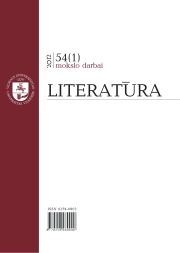Kristijono Donelai onelaičio Metų kompozicijos problemos
On Composition of Kristijonas Donelaitis ’ Metai – Selected Problems
Author(s): Vaidas ŠeferisSubject(s): Literary Texts
Published by: Vilniaus Universiteto Leidykla
Summary/Abstract: The article deals with the crucial question of Kristijonas Donelaitis’ literary work: is his Metai (The Seasons) a single and coherent literary text or a group of four independent poems? The first publisher of Donelaitis’ work Liudwig Rhesa (Liudvikas Rėza) introduced in 1818 for the first time the title Metai (which was not given by Donelaitis himself), presented four seasons as a single poem and held on the traditional seasons-sequence, beginning the text with spring and ending it with winter. Next publishers August Schleicher (1865) and Georg Hans Ferdinand Nesselmann (1869) accepted neither the title Metai nor the idea of four seasons as a single poem. Especially Nesselmann was strongly against Rhesa’s concept and pointed out its textological and historical “inaccuracy”. Modern Lithuanian philology, however, came back to the concept of Rhesa. In this paper, the analysis of The Seasons shows that we need a more accurate approach to the question of its composition. According to the studies of Rimvydas Šilbajoris, Tomas Venclova, and Saulius Žukas, there is no single plot in The Seasons, which could serve as a basis for a poetic coherence of the poem. The structure of Donelaitis’ work is based on binary oppositions between an “ideal world” and “real world” – two semiotic paradigms existing in the dialectic relation to each other. Thus, the paradigmatic level of the text, on which both opposite semiotic worlds unfold, has a dominant position over the syntagmatic text relations. That is why the syntagmatic reading of Donelaitis’ work is inaccurate: four Donelaitian seasons build a coherent semiotic universe (which we traditionally call the seasons), but are not composed as a strong syntagmatic structure. The article suggests that The Seasons should be understood as a poetic cycle of four parts (seasons). In this circular composition, there is no reason to talk about “the beginning” or “the end” of the text. All four parts are equal in the hierarchy to the poetic whole and should be interpreted simultaneously (for example, as four pictures in an art exhibition). There is no reason to deny the traditional sequence of reading of The Seasons from the spring to the winter, but this should not imply any interpretative conclusions. The Seasons of Donelaitis is a coherent poetic universe, but not a coherent literary text with a strong composition.
Journal: Literatūra
- Issue Year: 54/2012
- Issue No: 1
- Page Range: 39-55
- Page Count: 17
- Language: Lithuanian

